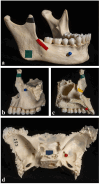Retention of skull anatomy knowledge in dental education: a comparative study
- PMID: 40599167
- PMCID: PMC12209205
- DOI: 10.3389/fdmed.2025.1596610
Retention of skull anatomy knowledge in dental education: a comparative study
Abstract
There is limited evidence regarding the retention of essential basic science knowledge among dental students and professionals. Understanding the anatomy of the skull, osteology, is crucial as it provides the structural framework essential for comprehending head anatomy, where various soft tissue components are organized. This study aims to evaluate and compare the retention of osteological knowledge across different stages of dental education and professional practice. Specific anatomical structures on selected skull bones and the complete cranium, taught at the pre-clinical level and including clinically and radiographically significant landmarks, were marked for assessment. The study evaluated the ability of second year and fifth year undergraduate dental students, as well as postgraduate students at various stages of specialist training in different dental fields, to independently identify these marked anatomical structures. The study demonstrated significantly higher identification accuracy among second year students compared to fifth year and postgraduate students (p < 0.05). Second year students achieved over 90% accuracy for individual skull bones, with slightly lower accuracy for the entire cranium (85.9%). Fifth year students showed markedly lower retention, with accuracy below 50%, ranging from 20.8% (cranium) to 48.3% (mandible). Postgraduate students performed similarly to fifth year students, notably with only 11.8% accuracy for the sphenoid bone. Significant differences in accuracy were observed among postgraduate specialties (p < 0.05), with oral surgery and oral medicine specialists achieving the highest accuracy (81.2% for the mandible). However, no significant correlation between years of experience and accuracy was observed among the postgraduate groups (p = 0.45). Our results indicate that clinically and radiologically relevant anatomical knowledge is better retained over time, while overall osteological knowledge significantly declines. This highlights the need for strategies beyond initial learning to enhance long-term retention. Integrating clinical, radiological, and surface anatomy into continuing dental education could substantially improve knowledge retention. Furthermore, our findings suggest potential benefits from increased vertical integration and encourage broader discussion regarding the traditional separation between pre-clinical and clinical training phases.
Keywords: anatomy; basic sciences; clinical dentistry; cranium; knowledge retention.
© 2025 Thune, Tostrup Kristensen, Khan, Utheim, Lewi Hammer and Sehic.
Conflict of interest statement
The authors declare that the research was conducted in the absence of any commercial or financial relationships that could be construed as a potential conflict of interest.
Figures

Similar articles
-
The educational effects of portfolios on undergraduate student learning: a Best Evidence Medical Education (BEME) systematic review. BEME Guide No. 11.Med Teach. 2009 Apr;31(4):282-98. doi: 10.1080/01421590902889897. Med Teach. 2009. PMID: 19404891
-
Systemic pharmacological treatments for chronic plaque psoriasis: a network meta-analysis.Cochrane Database Syst Rev. 2021 Apr 19;4(4):CD011535. doi: 10.1002/14651858.CD011535.pub4. Cochrane Database Syst Rev. 2021. Update in: Cochrane Database Syst Rev. 2022 May 23;5:CD011535. doi: 10.1002/14651858.CD011535.pub5. PMID: 33871055 Free PMC article. Updated.
-
Systemic pharmacological treatments for chronic plaque psoriasis: a network meta-analysis.Cochrane Database Syst Rev. 2017 Dec 22;12(12):CD011535. doi: 10.1002/14651858.CD011535.pub2. Cochrane Database Syst Rev. 2017. Update in: Cochrane Database Syst Rev. 2020 Jan 9;1:CD011535. doi: 10.1002/14651858.CD011535.pub3. PMID: 29271481 Free PMC article. Updated.
-
Sertindole for schizophrenia.Cochrane Database Syst Rev. 2005 Jul 20;2005(3):CD001715. doi: 10.1002/14651858.CD001715.pub2. Cochrane Database Syst Rev. 2005. PMID: 16034864 Free PMC article.
-
Pulp treatment for extensive decay in primary teeth.Cochrane Database Syst Rev. 2018 May 31;5(5):CD003220. doi: 10.1002/14651858.CD003220.pub3. Cochrane Database Syst Rev. 2018. PMID: 29852056 Free PMC article.
References
LinkOut - more resources
Full Text Sources

